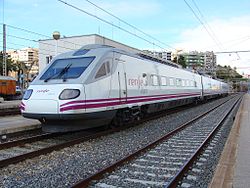| Alaris | |
|---|---|
 | |
| Overview | |
| Locale | Madrid and Valencia, Spain |
| Transit type | Regional rail |
| Operation | |
| Operator(s) | RENFE |
Alaris was the brand name of the regional rail network run by the Spanish national rail company Renfe Operadora that connected the major cities of Madrid and Valencia, and Barcelona and the main cities of the Valencian community, between 1999 and 2013. [1]
